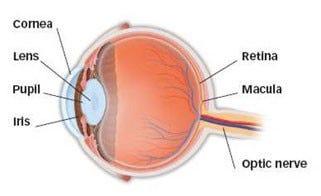Understanding Motion Blindness: The Intricacies of Akinetopsia
Written on
Chapter 1: The Occipital Lobe and Visual Processing
When you touch the back of your head, just above your neck, you're resting on the occipital lobe—your brain's center for visual processing. This region is one of the four primary divisions of the brain, essential for how we perceive the world visually.
As we engage with our surroundings visually, intricate calculations and operations occur subconsciously, leading some researchers to suggest we all possess an innate mathematical ability. For instance, when a driver navigates a winding road, her brain automatically computes angles to determine the appropriate timing and degree of her steering adjustments.
A critical aspect of visual perception is the ability to detect motion, which is fundamentally linked to the concepts of "how much" versus "how many." Counting discrete objects—like the seven post-its cluttering my desk—does not involve motion. However, assessing the amount of coffee in my cup requires an understanding of liquid dynamics; my brain must recognize when to cease pouring to prevent spills.

Imagine the challenge of not being able to gauge when a liquid is nearing the brim of a cup or experiencing the fluidity of your driving. Our understanding of brain function often stems from cases where neurological processes malfunction, as seen in individuals with a unique visual impairment known as motion blindness, or akinetopsia.
The occipital lobe consists of multiple components, each responsible for different aspects of visual experience. Notably, the V5 region is crucial for processing motion. When functioning correctly, V5 enables us to perceive motion fluidly. In contrast, those suffering from akinetopsia see a series of static images rather than a seamless flow.
There are two main forms of motion blindness: inconspicuous akinetopsia and gross akinetopsia. In inconspicuous akinetopsia, individuals experience lingering images longer than normal, akin to a multiple exposure photograph.

Although the precise physiological cause of inconspicuous akinetopsia remains unknown, some patients have reported its onset after using specific prescription medications. According to Dr. Hayk S. Arakelyan from Yerevan State University, high doses of certain antidepressants can trigger this condition, which typically resolves when the dosage is lowered.
Conversely, gross akinetopsia is a rare and more severe form of motion blindness caused by lesions in the V5 area, rendering the individual largely unable to perceive motion. Much of our knowledge about this condition comes from a notable case involving a patient referred to as LM.
Chapter 2: The Case of Patient LM
LM was a 43-year-old woman diagnosed with blood clots in her brain, leading to bilateral lesions in her visual cortex. These lesions disrupt normal brain function, severely impacting motion perception.
The implications of her diagnosis were profound. Everyday tasks like driving or pouring coffee became fraught with difficulty. She described a scenario where a car would seem stationary until it suddenly appeared close to her, seemingly without movement. Similarly, when she attempted to pour tea, the cup appeared empty, and the tea seemed to freeze until it overflowed.
Since there were no effective treatments for her condition, LM had to rely on her other senses to compensate for her inability to perceive motion.
How do healthy brains with intact V5 regions perceive motion? The retina at the back of our eyes contains light-sensitive cells that send signals through neural circuits to the visual processing center in the occipital lobe. In a functioning brain, motion information is processed in the V5 region.

Researchers are actively studying the V5 region to gain deeper insights into motion perception, although comprehending the complete picture remains a complex challenge. Next time you witness a car zoom by or unwind with a show, take a moment to appreciate the intricate workings of your brain's V5 region, allowing you to effortlessly perceive movement.
This video, titled "Motion Blindness - Akinetopsia: The Ways Your Brain Can Break," explores the fascinating aspects of motion blindness and its neurological basis.
In another insightful video, "Akinetopsia," viewers gain further understanding of this rare condition and its implications on daily life.